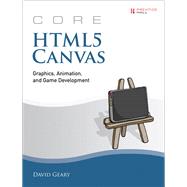
What is included with this book?
David Geary is a prominent author, speaker, and consultant who teaches developers how to implement web applications. He wrote the best-selling books on both Java component frameworks: Graphic Java 2: Swing, Third Edition (Prentice Hall, 1999), and (with Cay Horstmann) Core JavaServer™ Faces, Third Edition (Prentice Hall, 2010). David is a prolific speaker who is a three-time JavaOne rock star. In 2011, David co-founded the HTML5 Denver meetup group.
Preface xv
Acknowledgments xxiii
About the Author xxv
Chapter 1: Essentials 1
1.1 The canvas Element 1
1.2 Canvas Contexts 8
1.3 Canonical Examples in This Book 12
1.4 Getting Started 14
1.5 Fundamental Drawing Operations 22
1.6 Event Handling 26
1.7 Saving and Restoring the Drawing Surface 33
1.8 Using HTML Elements in a Canvas 36
1.9 Printing a Canvas 46
1.10 Offscreen Canvases 51
1.11 A Brief Math Primer 53
1.12 Conclusion 64
Chapter 2: Drawing 65
2.1 The Coordinate System 67
2.2 The Drawing Model 68
2.3 Drawing Rectangles 70
2.4 Colors and Transparency 72
2.5 Gradients and Patterns 76
2.6 Shadows 83
2.7 Paths, Stroking, and Filling 88
2.8 Lines 103
2.9 Arcs and Circles 124
2.10 Bézier Curves 137
2.11 Polygons 144
2.12 Advanced Path Manipulation 150
2.13 Transformations 170
2.14 Compositing 181
2.15 The Clipping Region 187
2.16 Conclusion 198
Chapter 3: Text 201
3.1 Stroking and Filling Text 202
3.2 Setting Font Properties 207
3.3 Positioning Text 210
3.4 Implementing Text Controls 225
3.5 Conclusion 252
Chapter 4: Images and Video 253
4.1 Drawing Images 254
4.2 Scaling Images 259
4.3 Drawing a Canvas into a Canvas 266
4.4 Offscreen Canvases 270
4.5 Manipulating Images 274
4.6 Clipping Images 302
4.7 Animating Images 306
4.8 Security 312
4.9 Performance 313
4.10 A Magnifying Glass 321
4.11 Video Processing 328
4.12 Conclusion 337
Chapter 5: Animation 339
5.1 The Animation Loop 340
5.2 Calculating Frame Rates 358
5.3 Scheduling Tasks at Alternate Frame Rates 359
5.4 Restoring the Background 360
5.5 Double Buffering 364
5.6 Time-Based Motion 367
5.7 Scrolling the Background 370
5.8 Parallax 377
5.9 User Gestures 383
5.10 Timed Animations 385
5.11 Animation Best Practices 390
5.12 Conclusion 391
Chapter 6: Sprites 393
6.1 Sprites Overview 394
6.2 Painters 398
6.3 Sprite Behaviors 411
6.4 Sprite Animators 417
6.5 A Sprite-Based Animation Loop 424
6.6 Conclusion 425
Chapter 7: Physics 427
7.1 Gravity 428
7.2 Warping Time 450
7.3 Time-Warp Functions 456
7.4 Warping Motion 458
7.5 Warping Animation 473
7.6 Conclusion 482
Chapter 8: Collision Detection 483
8.1 Bounding Areas 483
8.2 Bouncing Off Walls 488
8.3 Ray Casting 490
8.4 The Separating Axis Theorem (SAT) and Minimum Translation Vector (MTV) 495
8.5 Conclusion 541
Chapter 9: Game Development 543
9.1 A Game Engine 544
9.2 The Ungame 572
9.3 A Pinball Game 589
9.4 Conclusion 614
Chapter 10: Custom Controls 615
10.1 Rounded Rectangles 617
10.2 Progress Bars 625
10.3 Sliders 631
10.4 An Image Panner 643
10.5 Conclusion 655
Chapter 11: Mobile 657
11.1 The Mobile Viewport 659
11.2 Media Queries 666
11.3 Touch Events 671
11.4 iOS5 677
11.5 A Virtual Keyboard 682
11.6 Conclusion 701
Index 703
The New copy of this book will include any supplemental materials advertised. Please check the title of the book to determine if it should include any access cards, study guides, lab manuals, CDs, etc.
The Used, Rental and eBook copies of this book are not guaranteed to include any supplemental materials. Typically, only the book itself is included. This is true even if the title states it includes any access cards, study guides, lab manuals, CDs, etc.